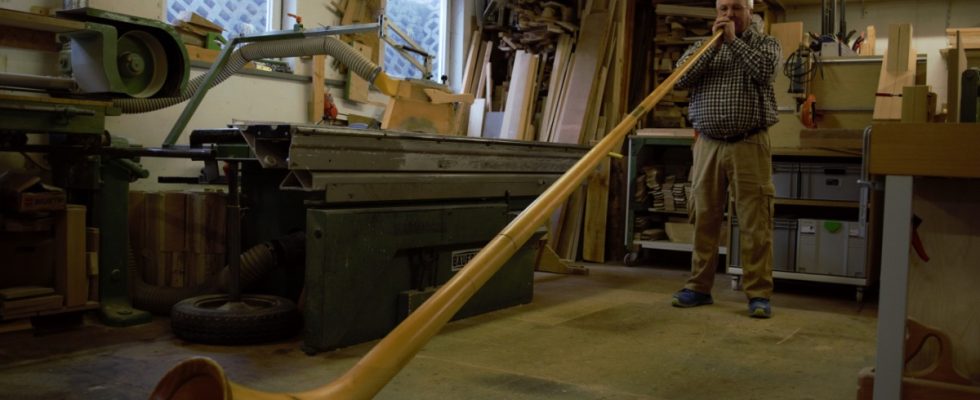Thomas Rupp enjoys spending time in his workshop. Here the 59-year-old stores a selection of wood of various shapes and sizes. Everything has its place because everything is needed. There is something meditative about this work with wood, he says, shortly before he holds an elongated, curved wooden blank in his hands and carefully moves it along the router with a focused gaze. It gets loud and wood chips fly. Then, after a short while, he lifts the blank, looks at it carefully and puts it aside.
Thomas Rupp builds alphorns. And that has been the case for around 35 years. The blank milled here will later be part of a cup, which is the base of the alphorn. The trained carpenter and vocational school teacher from Seeg is one of a manageable number of people in the Allgäu who still make these instruments, which are around 3.60 meters long, largely by hand. You won’t find a CNC milling machine like the one used in some other industrial companies.
Processing is important for a good alphorn, says Rupp. This means that the alphorn should, if possible, have no steps, but should have an even, smooth inner surface. This is also why the 59-year-old works a lot by hand, as a machine would often not be able to do the fine work on the inside and outside as well.
“For the most part, I use local spruce wood for the pipe,” he says. For the wreath, however, he chooses a durable hardwood, which is important as protection for the spruce and to stabilize the tone. His mouthpieces are made of apple tree. This wood is easy to turn, he says. What all woods have in common is that they are stored gently and dry.
For a long time, the alphorn was considered extinct in the Allgäu and only celebrated a return in the late 1950s, after a district home care officer from Marktoberdorf bought three shepherd’s instruments from Switzerland and distributed them to various musicians in Oberallgäu. He wanted to bring the alphorns back to the region, since the Allgäu and the alphorn have a long tradition. Finally, the oldest image of an alphorn player to date was found here.
This can be seen on a winged altar from 1568 in the St. Anna Chapel, at an altitude of almost 1,100 meters in Rohrmoos near Oberstdorf. There are only a few brush strokes, but the strikingly long instrument with the bell, which is clutched by a person, can be clearly seen even in such a historical illustration. The instrument was originally played by shepherds.
In his own workshop in the basement, 58-year-old Thomas Rupp makes his alphorns – largely by hand.
(Photo: Felix Hamann)
“These cannot be compared with today’s alphorns,” says Rupp. It starts with the construction. In the past, shepherds often had no plug-in connections and were therefore one-piece. In addition, the instruments were shorter and had a smaller range. The carpenter also finds it difficult to imagine a common myth that shepherds used to communicate using the alphorn. However, it seems more plausible to him that the alphorns were used as a lure for livestock. Or just to make music in between.
“Shepherds were not primarily instrument makers, so it was difficult for them to make the instrument,” says Rupp. Last but not least, they probably wouldn’t have had the money for expensive tools. In addition, they finally had to carve a thin pipe that was smooth on the inside and also had the right angle of inclination. “Anyone who carves a pipe like this once a year will be very frustrated when, after a lot of work, almost no sound comes out,” he can imagine. Possibly also a reason why there were fewer and fewer alphorns over time.
He loves the earthy, soft sound of the instrument
Rupp himself found out about their existence in a newspaper article in his home in Oberallgäu. A teacher there built these instruments together with students. The idea of building one himself was great, he says. In 1988 and 1989 the time had come. He made his first two alphorns. “I had been playing the trumpet for 13 years and just loved the idea of owning an alphorn,” says Rupp. It took him around 80 hours. He used stencils that he got – as well as the tools – from an acquaintance of his father.
“I had different expectations of the instrument 25 years ago than I do today,” he says. That’s why he always wants to improve his alphorns. However, he is satisfied with the instrument he regularly plays. And that’s already six years old. He usually makes a maximum of five alphorns a year and now charges between 2,500 and 3,000 euros for each of these unique pieces. This year, however, he hasn’t gotten around to it yet; the school year was too intense, as the teacher emphasizes.
“What I find beautiful about the alphorn is the earthy, soft sound,” says Rupp. He regularly plays the trumpet in the trombone choir of the Protestant parish in Füssen and also the alphorn at mountain services in the summer. And preferably alone. In any case, it is unlikely that the shepherds would play music together. He attaches great importance to a clear, perfect sound with the alphorn. That’s why he likes to play music on lakes with a smooth surface, such as the Lower Gaisalpsee near Oberstdorf. Not least because the body of water, in a perfect basin position, surrounded by mountains and forest areas, carries the echo particularly well.
His alphorns are now even played abroad. Just a few years ago he sold alpine horns as far away as Luxembourg. He even went to a customer’s 50th birthday and played. The effort was probably worth it. Last year for Christmas he made another alphorn for the customer.

